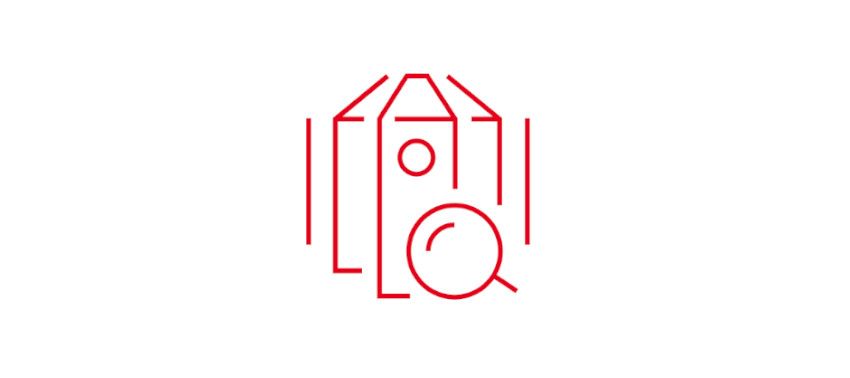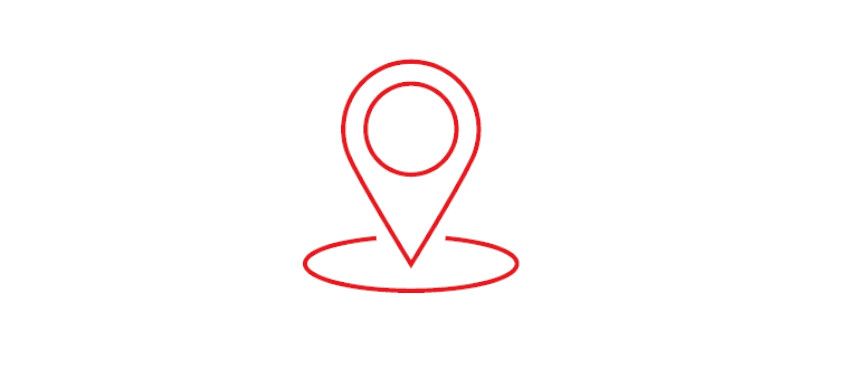Advantages of DuPont™ Tyvek® for the pharmaceutical industry
Advantages of DuPont™ Tyvek®
DuPont understands the need to ensure contamination free work places and meeting strict pharma regulatory requirements. For this reason, DuPont protective garments provide reliable protection of workers as well as sensitive pharmaceutical processes and products, based on scientific expertise in people protection and unique properties of the lightweight and durable Tyvek® fabric.
Manufactured by a flash-spinning process, Tyvek® fabric is made of strong, continuous, high density polyethylene fibers. The fibers are thermally bonded into a tight, homogeneous and soft fabric that is intrinsically breathable, does not shed fibers (‘ linting ’) and has inherent barrier properties, i.e. not reliant on a thin applied coating or layer. This unique combination of barrier protection and inherent breathability makes Tyvek® an ideal fabric for a wide range of protective applications. To learn more on protective powers of Tyvek® please go here.
Advantages of DuPont™ Tyvek®
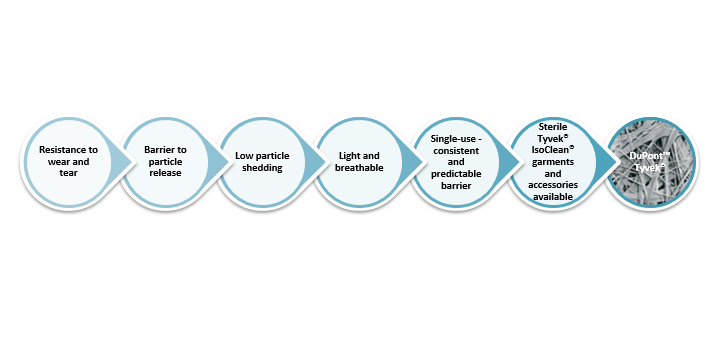
Comparison of DuPont™ Tyvek® with other fabrics SMS and MPF
Microporous film (MPF) fabrics are a bi-laminate material comprising a thin microporous film bonded to a spunbound polypropylene base. These fabrics offer limited durability since all barrier protection is lost when the protective film layer is abraded. In addition, their low air-permeability characteristics make them much less breathable than other fabrics. This results in poor wearer-comfort and heat control. The performance of spunbound/meltblown/spunbound (SMS) fabrics relies on a meltblown polypropylene layer sandwiched between two open polypropylene layers. This inner polypropylene layer functions as the main filter for particles. However, SMS fabrics tend to suffer from limited durability and relatively weak barrier performance due to their relatively open fiber structure. In addition, their high air permeability characteristics significantly compromise the barrier properties of the fabric making it only really appropriate for very basic protection and as a dirt barrier.
Abrasion: The figure illustrates fabric durability after 10 cycles of abrasion. At first glance SMS fabric remains unaffected but it has lower performance level. MPF protection barrier is impacted. The film gets abraded very easily and one can see that there are holes in the film. Only Tyvek® remains unaffected and has the highest protection level
Abrasion: Simulation of wear and tear in everyday use.
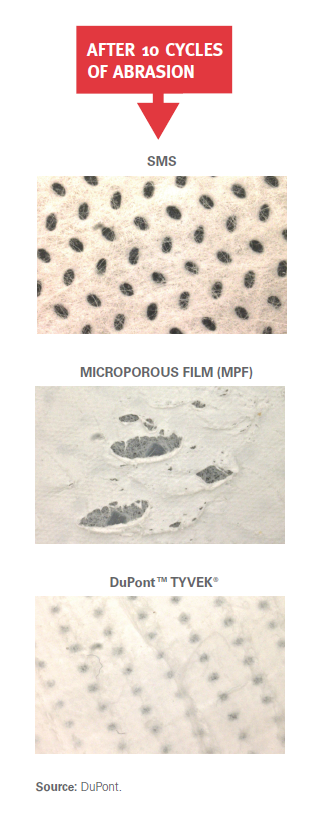
The effects of abrasion on fabric efficiency: Fabric abrasion can seriously undermine the protective efficiency of a fabric. For example, fabrics that rely on thin coatings or have an inherently weak physical structure can quickly and easily lose their resistance to penetration under operating conditions. This loss of protection is particularly dangerous because in many cases the damage is not readily apparent or is not discovered until after an exposure occurs. The susceptibility of some fabrics to a severe deterioration in penetration resistance following abrasion can be seen in the following hydrostatic pressure test. Hydrohead is an indicator for liquid barrier performance. It determines the resistance of a fabric to water penetration under slight pressure. Prior to the abrasion test Microporous Film offers the best resistance to liquid pressure. But after just 10 cycles of abrasion, its performance takes a spectacular dive, while SMS is less affected but starts from a much lower performance level, and Tyvek® continues to protect. After abrasion, Tyvek® penetration performance is the highest.
Liquid barrier performance. Hydrostatic Head: EN 20811. Before and after 10 cycles of abrasion (EN 530 - Method 2).
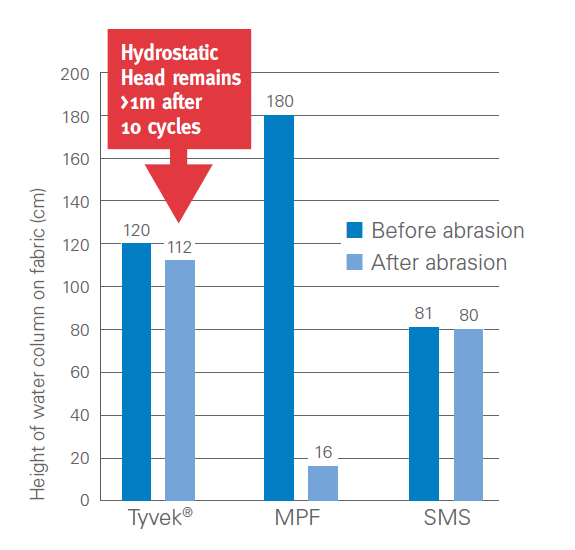
Permeation data: When it comes to protective apparel, it is crucial to differentiate between penetration and permeation. Penetration is the physical process whereby a liquid, vapour or gas passes through the material via ‘pores’ or ‘holes’ in the fabric. It is more relevant when referring to particle penetration of a fabric or whole suit. Permeation is the process by which a chemical, in the form of a liquid, vapour or gas, moves through protective clothing material on a molecular level. The standard test duration for permeation is up to 8 hours or until permeation has been detected.
A protective clothing material with excellent results in the penetration test may give only poor protection when exposed to the same chemical in larger quantities and/or for extended time. To determine whether a protective clothing material with a low penetration index is really a protection against a specific liquid chemical, the chemical permeation data needs to be consulted.
Knowing the toxicity or consequences of short- or long-term exposure to a hazard is essential. With this in mind, consider whether a coverall has been tested to the following standard: EN ISO 6529 which gives information concerning the chemical permeation and penetration of the fabric where the chemical is tested up to 480 minutes. Further assistance can be accessed in the
Instructions for Use attached to DuPont products packaging, where you can find permeation data for a selection of chemicals. Detailed permeation data for over than 450 chemicals can be accessed on www.safespec.dupont.co.uk.
Total Inward Leakage: When comparing their barrier performance of DuPont™ Tyvek® Type 5 coveralls with other Type 5 suits made of Microporous Film (MPF) and SMS (Spunbond/Meltblown/Spunbond), the models made of Tyvek® show a significantly lower Average Total Inward Leakage (TILA) according to EN ISO 13982-2* with an average value of less than 1%. The Type 5 product standard allows for an inward leakage of up to 15% in 8 out of 10 suits tested.
Total Inward Leakage (TILA): Average of the 10 suits and all activities EN ISO 13982 - (1 and 2). Dry particles Sodium Chloride NaCl 0,6 μm.
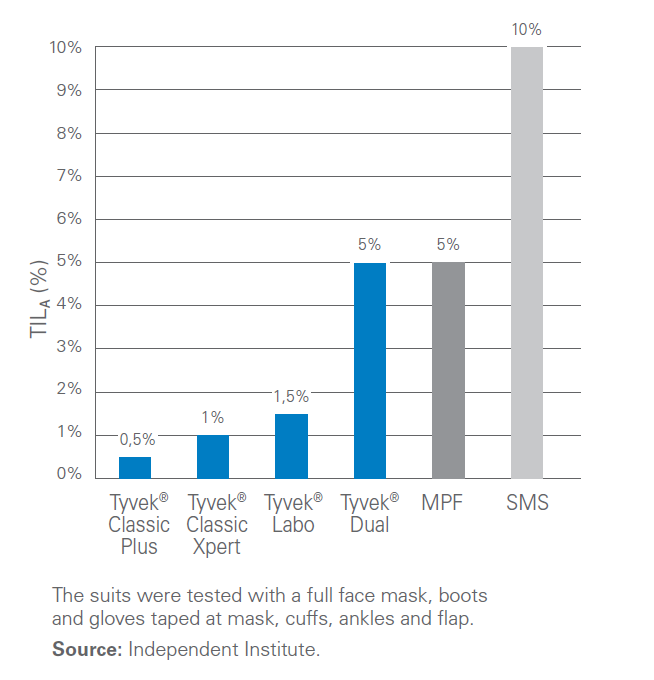
Comfort and breathability: Comfort is a somewhat subjective and personal matter but some key comfort factors frequently cited in wearer trials include:
· Garment design: ample freedom of movement when bending/stretching.
· Breathability: ability of the garment to allow sweat to evaporate and provide moisture vapor permeability.
· Feel on the skin, softness.
· Garment weight.
· Wearing undergarments such as cotton that absorb sweat improves the “feel” on the skin.
· Wearing long-legged and long-sleeved undergarments.
The Tyvek® barrier fabric from DuPont™ uses a proprietary non-woven fabric structure to provide a protective fabric that actually allows moisture vapor to pass through. The material is formed from High Density Polyethylene (HDPE) ultrafine continuous fibers which are laid down into a tough, light, homogeneous fabric with inherent vapor breathability characteristics on account of its microscopic lattice structure. This inherent ability to evacuate body moisture results in greatly improved wearer comfort in many Type 4, 5 and 6 applications. With their open structure, SMS coverall removes better the humidity than Microporous Film, by far. Tyvek® meets quite good performances during sweating. Microporous Film is the material that takes the longest time to remove humidity.


